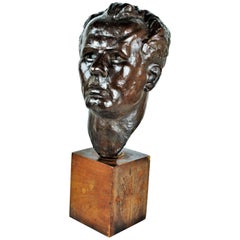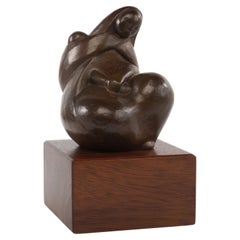Marina Nunez Del Prado
Vintage 1930s Bolivian Art Deco Figurative Sculptures
Bronze
Recent Sales
Vintage 1970s Bolivian Modern Figurative Sculptures
Bronze
Vintage 1970s Bolivian Modern Figurative Sculptures
Marble, Bronze
Marina Núñez del Prado for sale on 1stDibs
Marina Núñez del Prado was a celebrated Bolivian sculptor and one of the most respected sculptors from Latin America. Her work is highly sensuous, with rolling curves. She carved from native Bolivian woods, as well as black granite, alabaster, basalt and white onyx. Perhaps one of her most famous works is White Venus (1960), a stylized female body in white onyx. Another celebrated work is Mother and Child, sculpted in white onyx. Indigenous Bolivian cultures inspired much of her work. Del Prado was born in La Paz, Bolivia on October 17th, 1910. She first discovered her love of art in her youth while studying sculptural modeling techniques in La Paz. Her passion for sculpture was inspired by the work of Michelangelo, and she went on to study fine art at the Academy of Fine Arts in La Paz, graduating in 1930. Del Prado continued at her alma mater as an instructor of artistic anatomy and sculpture. She became the first woman to achieve a position as the chair of the Academy. While she was working at the Academy of Fine Arts, La Paz, Del Prado began exhibiting locally. She was very artistically active and collaborated with various artists, such as Cecilio Guzmán de Rojas, a Bolivian painter who led the indigenous art movement at that time. Similarly, Del Prado primarily focused her work on the rights of indigenous peoples and indigenismo, a political ideology centering the relationship of the indigenous population with the government.
Del Prado left her job at the university and her home city of La Paz to travel in 1938. She spent the next several years traveling through Peru, Uruguay and Argentina. She then traveled to other countries outside of South America, including Egypt, parts of Europe and the United States, where she studied for eight years in New York on a fellowship awarded by the American Association of University Women. While in New York, Del Prado won a Gold Medal for her exhibition “Miners in Rebellion.” This work was centered around the workers of the Bolivian region of Potosi. Shortly after this, in 1948, Del Prado moved back to La Paz, where she continued to make work inspired by the indigenous peoples of South America, as well as the landscape and culture of her homeland. She later moved to Peru in 1972, where she lived with her husband, Jorge Falcón, a writer native to Peru. With her four siblings, Del Prado donated the Casa Museo Marina Nuñez del Prado to the people of Bolivia in memory of her parents. The museum houses over 1000 works of art, mostly done by Del Prado and some by her sister, Nilda. Del Prado passed away in Lima, Peru in 1995.
In 1938, she left her post and traveled through Bolivia, Peru, Argentina, Uruguay, the United States, Europe and Egypt. From 1940–48, she worked and organized exhibitions of her work in the United States while on a scholarship. In 1946, "Miners in Revolt," inspired by the miners in Bolivia's Potosí Department, won a gold medal in a New York exhibition. In 1948 she returned to Bolivia, finally settling down in La Paz in 1958. By 1972, she moved to Peru where she lived with her husband, a Peruvian writer. Along her successful career she met outstanding artists such as Pablo Picasso, Constantin Brâncuși, poets Gabriela Mistral, Alfonsina Storni and Juana de Ibarbourou. She was also a friend of the Bolivian writer Franz Tamayo. Her work has been the subject of international and national critique. Botelho Gozalvez argues that her work is marked by two main characteristics: grace and strength. The strength is seen through her Andean landscapes and her grace is recognizable in the harmonious geometry of her works. Botelho claims that Nunez del Prado has a “genius loci” and distinguishes four periods in her work. The first period is characterized by the musical thematic of her work. The second period is characterized by the use of bidimensional sculpture and a social thematic. The third period is characterized by the tridimensional stone sculpture. It is also known as the ‘maternal’ period because of her Aymara Madonnas and other depictions of indigenous women. Finally, the fourth period is the neo-abstract which has been influenced by Picasso, Archipenko and Milles. In similar fashion Hector Herazo Rojas argues that her works are characterized by strength, grace and monumentality He also points out that her works revolve around the thematic of race, myth and tradition. Her sculptures of indigenous motherly figures and mythic animals can attest to this. Pedro Querejazu coincides with Herazo Rojas on her race thematic and suggests that her sculptures originated within the movement of ‘native’ realism. According to him, her later her work adopted a modern and international expression that achieved a final stage immersed in abstractism. This later work focused on the female figure and creatures of the Andes. On this later stage, del Prado worked with Amazonian tropical woods, bronze and stones such as granite, andesite, basalt, onyx and marble. Other critics like Eduardo Mendoza Varela, who reviewed her sculptures exhibition shown in the Luis Ángel Arango Library at the bank of the Republic of Colombia in Bogotá, Colombia, argues that her work is ‘miraculous’ and ‘mysterious’. His critique employs poetic metaphors to emphasize her skills and mastery of the materials in her sculptures. He considers the abstracted and reduced forms as possessing the ability to go beyond just physical representation but capture the spirit of the artist herself. The critic Guillermo Nino de Guzman also refers to her work as ‘genius’ and a constant force of creative energy in regards to her series Mujeres al Viento(Página 7, 2014). Finally, her work has inspired poetry verses. The Spanish poet Rafael Alberti has dedicated homage to her work.
In the 1970s, Marina Núñez del Prado established her residence and art studio in what would become the Museum Hose, located in 300 Ántero Aspillaga Street, right at the center of the El Olivar Forest. It became the first house in the whole of El Olivar to be declared National Cultural Heritage and in 1984 the house-museum of the Núñez del Prado Foundation was officially inaugurated in La Paz in honor of Marina Núñez del Prado's parents. The House Museum governed by the Foundation Nuñez Del Prado is a private museum that enriches the Bolivian heritage. For decades it was a home and studio to Marina Nunez del Prado, and now it has become the Casa Museo and a treasured place of history and talent to those of Bolivia. The museum contains 1,014 works by del Prado, which constitute the greater repository of her work including sculptures, drawings and sketches by Marina, thus making it the largest existing collection of her works. But within the museum, you will not only find the work of del Prado but also that of her sister Nilda, who was a great goldsmith and painter. The museum is filled with their family environment, works of her father, and the collections of Bolivian Silver, Colonial Art, Contemporary Painting and Handicrafts. The house is surrounded by a garden of sculptures that had changing results affected by the urban modifications of its surroundings. The workshop of the sculptor del Prado, located on the second level, has been considered as the heart of the house and the intervention revolves around it. For a large period, the situation of the home museum of Marina Nunez del Prado was one of the complications. At the time the museum had been closed and forgotten for almost 10 years due to lack of management and support. The closing was due to a break in its infrastructure during the initial construction of the American Tunnel and had remained closed to the public while many people claim the national or municipal government never took care of the situation. There exist many personal accounts of neighbors who had watched the museum remain neglected for years and described its importance to their community and art history. They speak highly of the museum and the work included as well as speak fondly of del Prado as an artist. In 2012, they published a note that restoration of the house would begin and that work was being done to solve the many architectural issues. It was reopened in April 2015 by the San Isidro District Council and the curatorial work made for the selection of the pieces being shown was made by Gustavo Buntinx.
Finding the Right Figurative-sculptures for You
Figurative sculpture is a modern art form in which artists create work that is typically representative of the visible world. However, sculptures that are considered to be figurative in style can definitely be inclusive of abstract elements. A wide range of antique, new and vintage figurative sculptures has been made over the years by both well-known and emerging artists, and these pieces can prove striking and provocative as part of your home decor.
Realistic representation in visual art has a very long history. And while figurative artists, whether figurative painters or sculptors, find inspiration in humans, animals and real-life objects, good figurative sculptures can make us think differently about how the real world should look. Just as figurative paintings might include Photorealistic human likenesses, they can also include elements of Surrealism and can suggest a creative and alternative reality. Figurative sculptures aren’t always realistic impressions of our world — depictions of the human form in classical Greek sculpture, for example, might emphasize beauty and physical perfection.
There are a variety of figurative sculptures on 1stDibs created by artists working in a number of styles, including Art Deco, Art Nouveau, mid-century modern and more. A large figurative sculpture can introduce an excellent focal point in a guest bedroom, while smaller works might draw the eye to spaces such as wall shelving or a bookcase that people may otherwise overlook.
When decorating your living room, dining room, home office and study areas with figurative sculptures, don’t be afraid to choose bold colors to inject brightness into neutral spaces. Texture is another factor to consider when purchasing figurative sculptures. A highly textural work of ceramics or wood will catch the eye in a sleek modern space, whereas a smooth, flat glass sculpture can offer an often much-needed contrast in a room that already has many textures.
On 1stDibs, find antique, new or vintage figurative sculpture or other kinds of sculpture for your home decor today.


